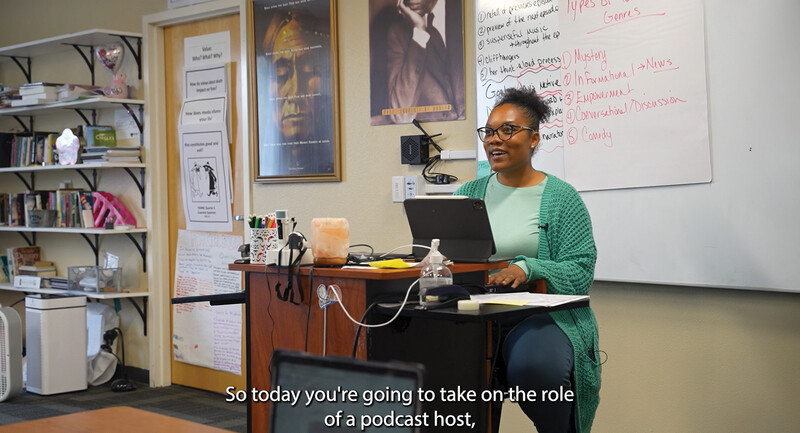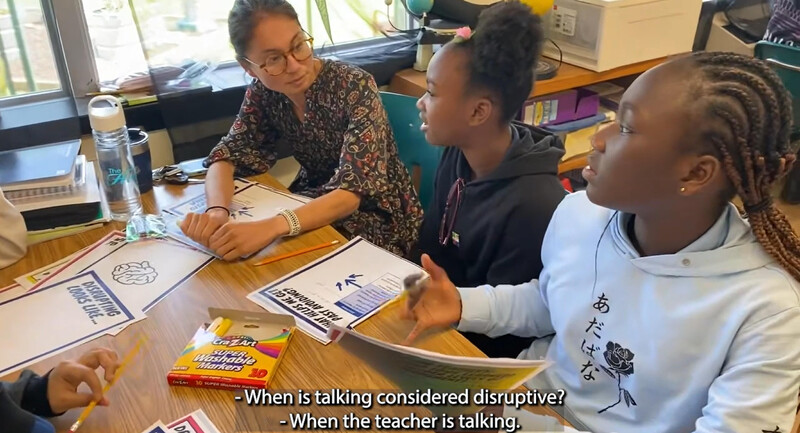Teaching is one of the only professions in which new hires bear the full responsibilities of the profession beginning on their first day on the job. Prospective educators may sit in a college lecture hall in the spring, and that very fall stands in front of their own class. This abrupt transition from student to teacher requires new teachers to quickly master the requisite job skills as they perform under the watchful eye of parents and administrators.
It is, of course then, understandable that new teachers rely on and attempt to use every strategy they learned from their student teaching experience, professional development workshops, and even those remembered fondly from their own school days while they anxiously strive to cover the curriculum. These are the Siren calls for new teachers.
The Sirens “honeyed voices” dangerously call to new teachers as they did to Odysseus, “Come closer . . . so you can hear our song . . . and sail on, a wiser man.” The problem is that these often relied upon strategies, although alluring, can result in new teachers losing their way.
Instead, we invite you to resist this temptation and follow these tips. . . as they will ease your journey as well as help you become more confident in the art of lesson design and make for smoother sailing:
- Chart Your Course
Avoid the Siren call of “Cover the Content”
Although we may feel constrained by standards and the curriculum, we actually have choices about what we focus on. Since there is so much to cover and it all seems equally important, we need guiding principles to govern our choices. This is good advice for new teachers designing lessons as well as screenwriters adapting beloved novels.
Peter Jackson, who had to eliminate certain characters and plot lines in order to transform The Lord of the Rings into a film stated, “The main reason is not just time or pace, but one of simple narrative focus …. A very simple rule of thumb that I use in movie storytelling is to try and further the story with each new scene” (Jackson, 1998). Just as Jackson excluded content that didn’t directly further the story of Frodo’s returning of the ring, we make similar choices as educators every day when we decide what pieces of information, passages of text, and activities and assignments we should include or exclude. As the “director” of learning, these choices should be deliberate so that everything from the Do Now to the closure is in the service furthering the “story” towards the desired learning outcome.
In order for teachers to maintain the “narrative focus”, they need to prioritize. Dr. Stephen Covey illustrates the concept of prioritizing using the image of placing the big rocks in a jar first before filling it with sand and water in order to fit it all in. However, since many teachers plan their lessons sequentially, the activities that come first, by default, often receive priority. An easy remedy is to identify the essential parts of each lesson during the planning stage. Then in your design, you will be prepared to abandon or shorten the less important activities to ensure your students are able to successfully complete the “big rocks” necessary to accomplish the desired learning outcome.
- Let Student Learning Guide Your Journey
Avoid the Siren call of “Add some novelty or variety”
We have many choices in how we teach a lesson whether it’s about The Civil War, To Kill a Mockingbird or the inner workings of the human body. We can organize jigsaw activities, fishbowls, or the ever-popular think/pair share. We can teach a whole class lesson, have students move through stations, or conference with individual students or small groups. Desks can be arranged in a circle, in rows or in small groups.
The Sirens may call to new teachers to incorporate the latest technology and most innovative strategies, but just as Odysseus resisted temptation in order to reach his final destination, you must remain focused on what will most effectively advance student learning. In order to make the best instructional choices, you can begin by asking yourself questions: If students are participating in a debate or speed dating activity, does the desk arrangement support the desired interaction? If you want students to do station work: Do the stations have meaningful choices or are they merely a means to control the flow of student traffic? If you’re using Breakout EDU: How are the students “amazing escape” meeting the learning outcomes? If students are working on a graphic organizer or a worksheet: Does the activity meet the requirements of a group-worthy task (Lotan, 2003) or is it just a busy sheet (Gonzalez, 2018)? Does it lead the students closer to the learning outcome or do the students view the completion of the organizer as the end in itself (Labaree, 2018)? Remember: The desired learning outcomes should always inform your teaching strategies.
- Circulate with a Purpose
Avoid the Siren call to circulate simply to promote on-task behavior
When students are working independently or in small groups, we habitually circulate around the room to assess student progress and level of engagement which typically means “Who is almost finished or far from complete?” or “Are the students focused and on-task?” However, rarely do we have a plan for our circulation other than following a predetermined clockwise or counterclockwise pattern. So how can we circulate more efficiently and effectively? Again, it starts with asking yourself some questions: “What am I looking for? “What will be the evidence?” “What will I do if I don’t see it?”
Similar to an attending physician in the ER who decides on the level of intervention required, we can prioritize what students we see, when we see them, and how we see them. If you are checking for understanding, then what evidence you are looking for? Are you glancing at students’ responses? Are you pausing to overhear conversations? Next, you need to decide: What do I plan to do with this data? Which student(s) need immediate support?
Once you know your purpose, then the real challenge is: How do I make students’ thinking visible quickly and efficiently so I know that they’re “getting it” One way is to create a dedicated space on the paper for students to write the central idea or have students highlight the key quote, main idea, or solution step to quickly assess understanding. Regardless of the strategy you use, it should provide quick feedback about each student’s level understanding that you can use to inform your instruction.
Once you have collected this information, it’s time to take action. You might ask for a whole class pause while you address a common misconception or share a powerful insight. Or, for students who are struggling with a similar skill or concept, you can organize small group mini-lessons while others are still working. You can also decide to slow down the pace or clarify or reteach concepts that are unclear.
A common mistake teachers make when circulating is to try and collect data and assess comprehension in a manner that is often too time-consuming. It is unrealistic to think that we can look over each student’s shoulder and attempt to decipher handwritten paragraphs, review multiple problem-solving steps, or engage in individual 3-5 minute conversations to determine if students are “getting it”. These methods only allow us to check on a limited number of students and leave us feeling ineffective. Remember: When you’re circulating, know your purpose and have a clear sense of what you’re looking for that can immediately inform instruction.
- Assess Each Student’s Understanding
Avoid the Siren call of the “Q and A”
Since teachers need real-time evidence of student understanding to know if our students are “getting it” or not, many of us often rely on an old favorite, the “Q & A”. It is a familiar drill. The teacher asks a question, a few familiar hands go up with the correct response, the teacher receives affirmative feedback, and promptly moves on. The problem with this approach is that it doesn’t allow teachers to check on each student’s level of understanding.
Wiggins and McTighe (McTighe, 2015) make the analogy that like the chef who tastes a meal and makes adjustments while cooking, teachers need to sample learning along the way through formative assessments and adjust the “ingredients” of their teaching based on results It is essential that a real-time check for understanding elicits a response from all students or at least a representative sample, not just a few outspoken voices. Dylan William suggests that “… the benefits of doing so are huge. It means that you can find out what’s going wrong with students’ learning when they’re right in front of you and that you can put the whole class’s learning back on track right away.” (William, 2015)
If you continually embed checks for understanding into the lesson, you can immediately adjust your approach to meet your students’ needs. You can then decide to slow down the pace, clarify or reteach concepts that are unclear, or provide students more practice before moving forward. If only a few students are struggling, you can pull students that have common misconceptions together for a mini-lesson while others continue working. The problem with many other types of assessments such as exit tickets and graded assignments is that they don’t uncover gaps in students’ knowledge until long after students have left the classroom. Real-time checks for understanding should inform teachers how to adjust their teaching strategies during the lesson in response to student learning.
- Use Less Scaffolds, Provide More Feedback
Avoid the Siren call of doing all the heavy lifting for the students
We want our students to succeed, but when we over-scaffold, even with the best intentions, we are not doing our students any favors. Real life demands that students learn how to solve complex problems and operate in the world without excessive supports because the goal of education is transferred (Wiggins, 2010). As Linda Darling-Hammond states “If what you’ve done is memorize information and spit it back on a test, you will be utterly unprepared for [our changing] world. They need work in the school that allows them to take up a problem, figure out how to find the resources that will be needed to solve that problem, work with others to design a solution, test it, evaluate it, revise it, and be able to generate their own progress in learning.”
Unfortunately, teachers often design activities that simply assess how well students “do school” as they are rewarded by the speed at which they solve problems using a prescribed formula, select correct answers off a predetermined list, fill in boxes on a graphic organizer, and otherwise fit all of the round pegs into the corresponding round holes. But just as a new little league player is continually encouraged as he swings and misses and coached on how to improve his stance, we must intentionally design sufficiently challenging opportunities that allow students, with our steady guidance and support, to achieve greater independence. According to Jessica Lahey, “They need every minute, every learning opportunity inherent in their failures before they face the much greater challenges and consequences that await them right around the corner….” (Gonzalez, 2015) It’s okay to scaffold less and allow for failure as long as there is meaningful and timely feedback that allows students to make improvements.
This approach requires a different way to teach, and it requires teachers to learn how to provide meaningful feedback. Meaningful feedback is feedback that enables students to make immediate adjustments and improvement during the learning process. Currently, the way teachers primarily provide feedback is through grading. We return papers with letter grades and comments, provide corrections on tests and quizzes, as well as attempt to quantify and explain seemingly subjective performance criteria. These methods are, of course, a type of feedback, but they do not sufficiently meet the requirements of meaningful feedback.
While providing meaningful feedback can be time-consuming, most teachers already possess a tool that is underutilized for this purpose – the rubric. Typically students look at the rubric twice – once when it is presented at the start of the project and then again when there is a grade attached. Neither offers an opportunity for students to make improvements along the way. The rubric can be leveraged during the process through self, peer, and teacher assessment to help students measure their progress, and move from where they currently reside on the learning progression to where they want to be.
In addition, technology can provide an efficient and effective means for feedback. Tech tools such Google Forms that can be formatted to indicate the degree to which a student’s work is meeting the desired end goal. Regardless of the means, meaningful feedback must provide the opportunity for students to use it to revise their thinking or adjust their performance accordingly. As providing feedback can be time-consuming and take up valuable instructional time, a helpful guiding principle to remember is: “no time to give and use feedback” actually means “no time to cause learning.“ (Wiggins, 2012)
- Allow Time For Reflection:
Avoid the Siren call to “move on”
We need to be mindful that during a typical school day students transition between multiple classes in which they recite Shakespeare, perform dissections, apply the Pythagorean Theorem, and take exams that ask them to recount the weaknesses of the Articles of Confederation. We must, therefore, give our students time to pause, process, and construct meaning from what they learn. Costa and Kallick suggest that “reflecting on work enhances its meaning. Reflecting on experiences encourages insight and complex learning. We foster our own growth when we control our learning. . . .” (Costa & Kallick, 2008)
To encourage reflection, we can ask students through short writing exercises: What new information did you learn? How does this connect to what you already know? What questions do you still have? After students think through writing, they can then engage in small group discussions and the teacher can quickly circulate to listen and discern students’ level of understanding. Wiggins and McTighe remind us that “understanding must be “earned” by the learner, and that the teacher’s job is to facilitate “meaning-making,” not simply present information.” (McTighe, 2015) We can’t underestimate the value of reflection to help students consolidate their learning, and commit it to long-term memory.
Avoid the Sirens as you Navigate Your Journey
There are not enough hours in the day for new teachers to become proficient in each aspect of the profession during their first few years; luckily mastery is not a prerequisite to being an effective teacher. As educators, it is our job to try to deliberately craft experiences and cultivate an environment that will foster learning, in order to impart the skills and strategies students need for whatever path they choose.
We hope you will resist the calls of the Sirens, and heed these suggestions. . . because once you row “past the Sirens, a choice of routes is yours” to develop into the kind of teacher you want to be for your students.
Mark Wise is the supervisor for curriculum and instruction at West Windsor-Plainsboro Regional School District in New Jersey. Follow him on Twitter. Beth Pandolpho is an English teacher at West Windsor-Plainsboro High School North in Plainsboro, New Jersey. She has a Master’s of Science in Reading and has taught at the high school and college level for over 20 years. She is primarily interested in meeting the social and emotional needs of students to help them thrive both personally and academically. She can be reached at beth.pandolpho@wwprsd.org or on Twitter @bethpando.








